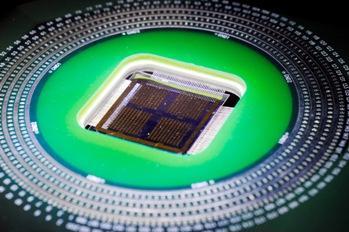Researchers at the School of Materials Science and Engineering at the Georgia Institute of Technology have developed piezoelectrically modulated resistive memory (PRM) devices using zinc oxide nanowires.
 Device arrays under study
Device arrays under study
The new device, which operates on flexible substrates, controls read-write access of memory cells by electromechanical modulation. According to Zhong Lin Wang, who developed the device with his student Wenzhuo Wu, the zinc oxide nanowire-based technology provides communication between electronic devices and mechanical actions in the biological world.
The application of strain by mechanical action modifies the piezoelectric semiconducting material’s resistance, which can be determined electronically. The new device is based on the fact that zinc oxide, a piezoelectric material, generates a charge potential due to application of strain or when it is deformed mechanically.
The generated piezoelectric charge is utilized by PRM devices to control the current passing via the zinc oxide nanowires placed at the center of the devices. This is the fundamental rule of piezotronics. The charge produces polarity in the nanowires and augments the electrical resistance similar to gate voltage acting in a traditional transistor.
The Georgia Tech scientists have developed non-volatile resistive switching memories to function as a storage medium based on huge-scale fabrication technologies for zinc oxide nanowire arrays. These piezotronic instruments can be written, read and rewritten. The researchers produced the zinc oxide nanowires with dimensions of 50µm length and 500nm diameter in a high-temperature furnace using a physical vapor deposition method. Oxygen plasma is used to decrease the crystalline defects in the nanowires in order to control their conductivity. These arrays are then shifted to a flexible substrate.
The piezotronic memory cells can be used for developing full self-powered nanoelectromechanical systems on a single chip. The research team has already exhibited other important elements such as wireless transmitters, sensors and nanogenerators. The U.S. Department of Energy, the U.S. Air Force, the National Science Foundation and the Defense Advanced Research Projects Agency sponsored the research work.